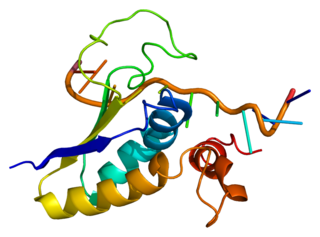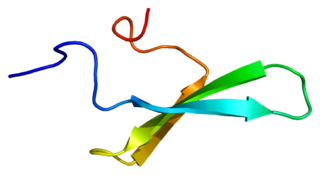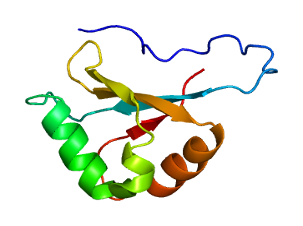Probable ATP-dependent RNA helicase DDX5 also known as DEAD box protein 5 or RNA helicase p68 is an enzyme that in humans is encoded by the DDX5 gene. [5]
Probable ATP-dependent RNA helicase DDX5 also known as DEAD box protein 5 or RNA helicase p68 is an enzyme that in humans is encoded by the DDX5 gene. [5]
DEAD box proteins, characterized by the conserved motif Asp-Glu-Ala-Asp (DEAD), are putative RNA helicases. They are implicated in a number of cellular processes involving alteration of RNA secondary structure, such as translation initiation, nuclear and mitochondrial splicing, and ribosome and spliceosome assembly. Based on their distribution patterns, some members of this family are believed to be involved in embryogenesis, spermatogenesis, [6] and cellular growth and division. This gene encodes a DEAD box protein, which is an RNA-dependent ATPase, and also a proliferation-associated nuclear antigen, specifically reacting with the simian virus 40 tumor antigen. This gene consists of 13 exons, and alternatively spliced transcripts containing several intron sequences have been detected, but no isoforms encoded by these transcripts have been identified. [5]
DDX5 has been shown to interact with:

rRNA 2'-O-methyltransferase fibrillarin is an enzyme that in humans is encoded by the FBL gene.

DEAD box proteins are involved in an assortment of metabolic processes that typically involve RNAs, but in some cases also other nucleic acids. They are highly conserved in nine motifs and can be found in most prokaryotes and eukaryotes, but not all. Many organisms, including humans, contain DEAD-box (SF2) helicases, which are involved in RNA metabolism.

ATP-dependent RNA helicase A is an enzyme that in humans is encoded by the DHX9 gene.

Spliceosome RNA helicase BAT1 is an enzyme that in humans is encoded by the BAT1 gene.

Splicing factor 1 also known as zinc finger protein 162 (ZFM162) is a protein that in humans is encoded by the SF1 gene.

Probable ATP-dependent RNA helicase DDX17 (p72) is an enzyme that in humans is encoded by the DDX17 gene.

Transcription elongation regulator 1, also known as TCERG1, is a protein which in humans is encoded by the TCERG1 gene.

Splicing factor 3B subunit 3 is a protein that in humans is encoded by the SF3B3 gene.

Probable ATP-dependent RNA helicase DDX6 is an enzyme that in humans is encoded by the DDX6 gene.

Eukaryotic initiation factor 4A-III is a protein that in humans is encoded by the EIF4A3 gene.

A-kinase anchor protein 8 is an enzyme that, in humans, is encoded by the AKAP8 gene.

Probable ATP-dependent RNA helicase DDX11 is an enzyme that in humans is encoded by the DDX11 gene.

Pre-mRNA-splicing factor ATP-dependent RNA helicase PRP16 is an enzyme that in humans is encoded by the DHX38 gene.

ATP-dependent RNA helicase DDX39 is an enzyme that in humans is encoded by the DDX39 gene.

Probable ATP-dependent RNA helicase DDX56 is an enzyme that in humans is encoded by the DDX56 gene.

Probable ATP-dependent RNA helicase DDX10 is an enzyme that in humans is encoded by the DDX10 gene.

ATP-dependent RNA helicase DDX19B is an enzyme that in humans is encoded by the DDX19B gene.

Probable ATP-dependent RNA helicase DDX23 is an enzyme that in humans is encoded by the DDX23 gene.

DEAD (Asp-Glu-Ala-Asp) box polypeptide 31, also known as DDX31, is a human gene.

ATP-dependent RNA helicase DDX50 is an enzyme that in humans is encoded by the DDX50 gene.